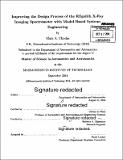| dc.contributor.advisor | Olivier de Weck and Rebecca A. Masterson. | en_US |
| dc.contributor.author | Chodas, Mark A | en_US |
| dc.contributor.other | Massachusetts Institute of Technology. Department of Aeronautics and Astronautics. | en_US |
| dc.date.accessioned | 2015-02-05T18:21:59Z | |
| dc.date.available | 2015-02-05T18:21:59Z | |
| dc.date.copyright | 2014 | en_US |
| dc.date.issued | 2014 | en_US |
| dc.identifier.uri | http://hdl.handle.net/1721.1/93796 | |
| dc.description | Thesis: S.M., Massachusetts Institute of Technology, Department of Aeronautics and Astronautics, 2014. | en_US |
| dc.description | Cataloged from PDF version of thesis. | en_US |
| dc.description | Includes bibliographical references (pages 85-87). | en_US |
| dc.description.abstract | Traditional systems engineering processes have supported the development of many complex and successful space systems. However, some systems experience significant cost and schedule overruns. Systems engineering capabilities need to be improved to manage the expected increase in complexity of future systems. Model-based systems engineering (MBSE) is a new systems engineering paradigm where system models instead of documents are used to track requirements, describe design, support trade studies and analyses, and track verification and validation activities. The system models can be studied to expose relationships and details that are impossible to find when information is scattered across many documents and analytical models. This thesis quantifies the advantages of MBSE over traditional systems engineering by comparing the historical development of the REgolith Imaging X-ray Spectrometer (REXIS), a student-built instrument on the OSIRIS-REx asteroid sample return mission, against a hypothetical development timeline that incorporates information from system models. The system models, constructed in SysML, capture the topological information about the system including the interfaces between all parts of the system, the uncertainty associated with each interface, and the path along which the consequences of selected design choices or requirements flow. The latter two types of information are captured with custom extensions to SysML. The models also provide useful statistics about the development process. The REXIS part count increased 104% between SRR and SDR and 163% between SDR and PDR while the interface count increased 93% between SRR and SDR and 174% between SDR and PDR. Evidence from REXIS shows that incorporating information from system models reduces design iteration and makes the design process more efficient. | en_US |
| dc.description.statementofresponsibility | by Mark A. Chodas. | en_US |
| dc.format.extent | 114 pages | en_US |
| dc.language.iso | eng | en_US |
| dc.publisher | Massachusetts Institute of Technology | en_US |
| dc.rights | M.I.T. theses are protected by copyright. They may be viewed from this source for any purpose, but reproduction or distribution in any format is prohibited without written permission. See provided URL for inquiries about permission. | en_US |
| dc.rights.uri | http://dspace.mit.edu/handle/1721.1/7582 | en_US |
| dc.subject | Aeronautics and Astronautics. | en_US |
| dc.title | Improving the design process of the REgolith X-ray Imaging Spectrometer with model-based systems engineering | en_US |
| dc.type | Thesis | en_US |
| dc.description.degree | S.M. | en_US |
| dc.contributor.department | Massachusetts Institute of Technology. Department of Aeronautics and Astronautics | |
| dc.identifier.oclc | 900609171 | en_US |
